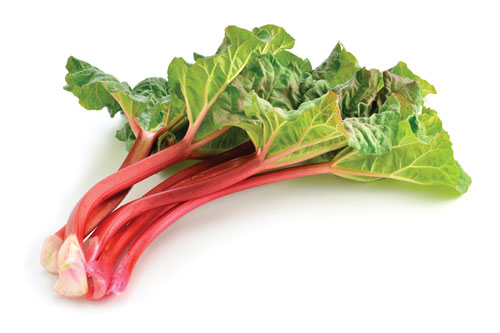
Michigan Fresh: Using, Storing, and Preserving Rhubarb (HNI48)
DOWNLOADJuly 26, 2023 - Joyce McGarry and Laurie Messing, Michigan State University Extension
This Document is offered in: English, Arabic, Espanol

Food Safety and Storage
- Pick or purchase rhubarb that are not damaged.
- Wash hands before and after handling fresh produce.
- Trim and discard leaves. The stalks can be kept in the refrigerator, unwashed and wrapped tightly in plastic, for up to 3 weeks.
- Wash rhubarb under cool running Do not use soap.
- Keep rhubarb away from raw meat and meat juices to prevent cross-contamination.
- For best quality and nutritional value, preserve no more than your family can consume in 12 months.
How to Preserve
Canning
Select young, tender, well-colored stalks. Trim off leaves. Wash stalks and cut into ½- to 1-inch pieces. In a large saucepan, add ½ cup sugar or a Splenda-type sugar substitute for each quart of rhubarb. Let stand until juice appears. Heat gently to boiling. Immediately pack rhubarb mixture in hot jars, leaving ½-inch headspace. Remove air bubbles, adjust headspace if needed, wipe jar rims with clean paper towel. Adjust two-piece lids and process.
See tables that follow for recommended processing times.
|
Recommended process time (in minutes) for rhubarb in a boiling-water canner. |
||||
|
|
Process time at altitudes of |
|||
|
Style of pack |
Jar size |
0 - 1,000 ft |
1,001 - 6,000 ft |
Above 6,000 ft |
|
Hot |
Pints or quarts |
15 |
20 |
25 |
|
Recommended process time (in minutes) for rhubarb in a dial-gauge pressure canner. |
||||||
|
|
Canner pressure (PSI) at altitudes of |
|||||
|
Style of pack |
Jar size |
Process time |
0 - 2,000 ft |
2,001 - 4,000 ft |
4,001 - 6,000 ft |
6,001 - 8,000 ft |
|
Hot |
Pints or quarts |
8 |
6 lb. |
7 lb. |
8 lb. |
9 lb. |
|
Recommended process time (in minutes) for rhubarb in a weighted-gauge pressure canner. |
||||
|
|
Canner pressure (PSI) at altitudes of |
|||
|
Style of pack |
Jar size |
Process time |
0 - 1,000 ft |
Above 1,000 ft |
|
Hot |
Pints or quarts |
8 |
5 lb. |
10 lb. |
Let jars sit undisturbed for 12 to 24 hours, check lids to be sure they’ve sealed, remove rings, wash jars, date, label and store. Food in jars that do not seal must be reprocessed in a clean jar with a new lid within 24 hours, refrigerated or frozen.
Tables were adapted from the National Center for Home Food Preservation (NCHFP), Selecting, Preparing and Canning Fruit: Rhubarb–Stewed¸ reviewed February 2018 (https://nchfp.uga.edu/how/can_02/rhubarb_stewed.html). The NCHFP adapted them from the Complete Guide to Home Canning (Agriculture Information Bulletin, No. 539). USDA, 2015.
Freezing
Choose firm, tender, well-colored stalks with good flavor and few fibers. Wash, trim and cut rhubarb into lengths to fit the package or cut it to the size and in the amount that you need for recipes. You may freeze rhubarb raw or blanched by heating rhubarb in boiling water for 1 minute and cooling in ice water for 1 minute.
Dry pack – Pack either raw or blanched rhubarb tightly into containers without sugar. Leave ½- to 1½-inch headspace dependent on container type. Seal, label, date and freeze.
Syrup pack – Pack either raw or blanched rhubarb tightly into containers, and cover with cold sugar syrup of choice. (See table.) Leave ½- to 1½-inch headspace dependent on container type. Seal, label, date and freeze.
|
Syrups for Use in Freezing |
||||
|
Type of syrup |
Percent syrup* |
Cups of sugar** |
Cups of water |
Yield of syrup in cups |
|
Very light |
10% |
½ |
4 |
4½ cups |
|
Light |
20% |
1 |
4 |
4¾ cups |
|
Medium |
30% |
1¾ |
4 |
5 cups |
|
Heavy |
40% |
2¾ |
4 |
5⅓ cups |
|
Very heavy |
50% |
4 |
4 |
6 cups |
*Approximate
**In general, up to one-fourth of the sugar may be replaced by corn syrup or mild-flavored honey. A larger proportion of corn syrup may be used if a very bland, light-colored type is selected.
References
- Andress, E., & Harrison, J. A. (2014). So easy to preserve (Bulletin 989). (6th ed.). University of Georgia Cooperative Extension.
- National Center for Home Food Preservation. http://nchfp.uga.edu/
- U.S. Department of Agriculture. (2015). Complete guide to home canning (Rev. ed.). (Agriculture Information Bulletin No. 539). http://nchfp.uga.edu/publications/publications_ usda.html
More information



 Print
Print Email
Email





